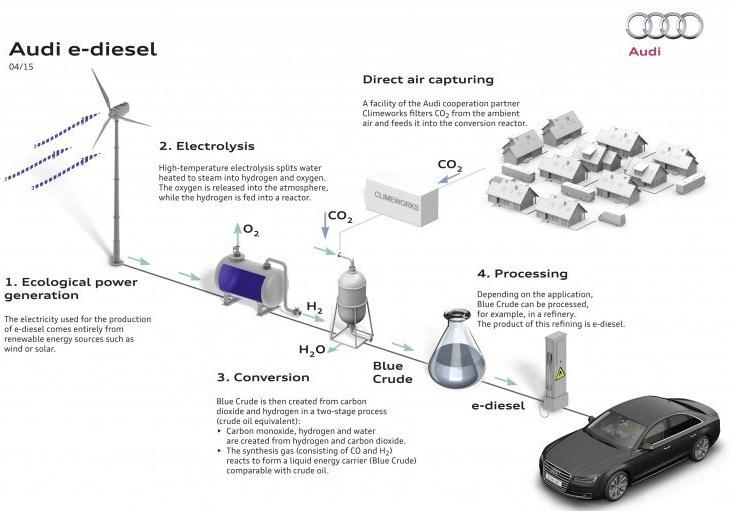The e-diesel uses a multi-step process. First electricity is used to split water into hydrogen and oxygen via reversible electrolysis (rSOC) at a very high efficiency of approximately 90 percent. That by itself already sounds like an amazing achievement. Next the hydrogen is mixed with carbon monoxide under high temperatures and pressure to create something Audi refers to as "blue crude". The carbon monoxide is obtained directly from the ambient air using direct air capturing technology from Swiss firm Climeworks. The blue crude is then further refined to create the synthetic diesel fuel, Audi claims about 80 percent of the blue crude can be converted into synthetic diesel.
While the whole process sounds rather energy-intensive, Sunfire claims the overall energy efficiency of the e-diesel is 70 percent. The e-diesel can be used on its own or can be mixed with conventional diesel fuel. Interestingly, the e-diesel promises to deliver superior quality over traditional diesel. Engines reportedly run quieter on e-diesel and fewer pollutants are being created. The press release mentions e-diesel is sulphur free and has a cetane number of roughly 70, ensuring a cleaner and better combustion.
Audi and Sunfire set up a pilot plant in Dresden, Germany that will manufacture 160 liters of e-diesel per day in the coming months.
Audi, German car manufacturer and project partner of sunfire, exposed the synthetic diesel t o laboratory tests , with the result that the fuel was approved . The analysis shows that its properties are superior to fossil fuel. T he synthetic sunfire diese l does not contain any sulphur or fossil oil and thus is particularly e co - friendly. sunfire - CTO Christian von Olshausen says : “The engine runs quieter and fewer pollutants are being created”. The cetane number is very high (roughly 70) and ensures a cleaner and better combustion as a blending component for conventional diesel fuel.The interesting part of this news is that this process delivers a method to store the electricity generated by renewables in a way that fits into our current energy infrastructure. Audi and Sunfire are planning to scale up production and hope to be able to sell e-diesel to the public for between 1 and 1.5EUR per liter, depending on the cost of electricity used to generate the fuel. We're not sure if this factors in taxes but if the price achieves the middle of that range it would be quite competitive with traditional diesel in Europe.
The power - to - liquids technology reaches system efficiencies of about 70 per cent. The centrepiece of the three - stage procedure is t he reversible electrolysis (rSOC) based on the Solid Oxide Power Core. The rSOC generates hydrogen with an efficiency of approximately 90 per cent . The main advantage comes to the fore when electricity prices rise to a level that makes hydrogen production unprofitable: After a short turnaround interval , the system can be switched to fuel cell mode and used to convert hydrogen reserve s or any another fuel back into power and heat.
